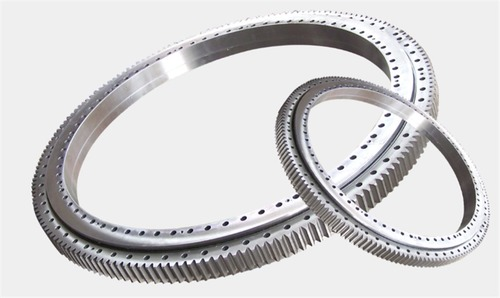How does slewing bearing work?
Slewing bearings usually consist of a rotating ring with an inner ring and several outer rings. This kind of bearing is characterized by a large contact area, allowing it to maintain high rotation accuracy and stability while bearing large loads. In addition, slew bearings are usually equipped with lubrication systems and sealing devices to ensure that the inside of the bearing is protected from external contamination and moisture.
- Working principle of slewing bearings
1.The motion of the rotating ring
The rotating ring in the slew bearing maintains close contact with the outer ring through the balls or rollers inside the bearing, thereby forming continuous friction. These balls or rollers support the rotating ring and keep it stable as it rotates under the power of an external drive.
2. load transfer
The design of slew bearings allows load transfer in all directions. This means that no matter which direction the load comes from, the slew bearing is able to effectively distribute it to various contact points, ensuring uniform load distribution. This characteristic makes slew bearings ideal for many industrial applications.
3. Accuracy maintained
Because slew bearings have large contact areas and high rotational accuracy, they are generally able to remain stable at high rotational speeds. In addition, by precisely controlling the lubrication system and adjusting the sealing device, it is also possible to ensure that the bearing maintains its accuracy and stability during long-term use.
2. Application fields of slewing bearings
Slewing bearings are widely used in various industrial fields due to their excellent performance and adaptability, such as engineering machinery, transportation, petrochemical industry, aerospace, etc. They play a vital role in these applications, supporting rotating parts, transmitting loads, maintaining accuracy and stability, etc.
3.Performance characteristics of slewing bearings
1. High load-bearing capacity: Due to its large contact area, slew plate bearings can withstand larger loads and are suitable for applications requiring high load-bearing capacity.
2. High precision: Due to their sophisticated design, slew plate bearings are usually able to maintain high rotation accuracy and stability, and are suitable for applications requiring high precision.
3. Strong adaptability: Slewing bearings can work in various harsh and extreme environmental conditions, such as high temperature, low temperature, high humidity and corrosive substances.
4. Easy to maintain: Slew plate bearings are usually equipped with lubrication systems and sealing devices for easy maintenance and care.
Slewing bearings are a type of bearing with special structural and design features. Their working principle is based on friction support between the rotating ring and the outer ring. Slewing bearings play a vital role in various industrial fields by precisely controlling load transfer, maintaining accuracy and stability, and other functions.



